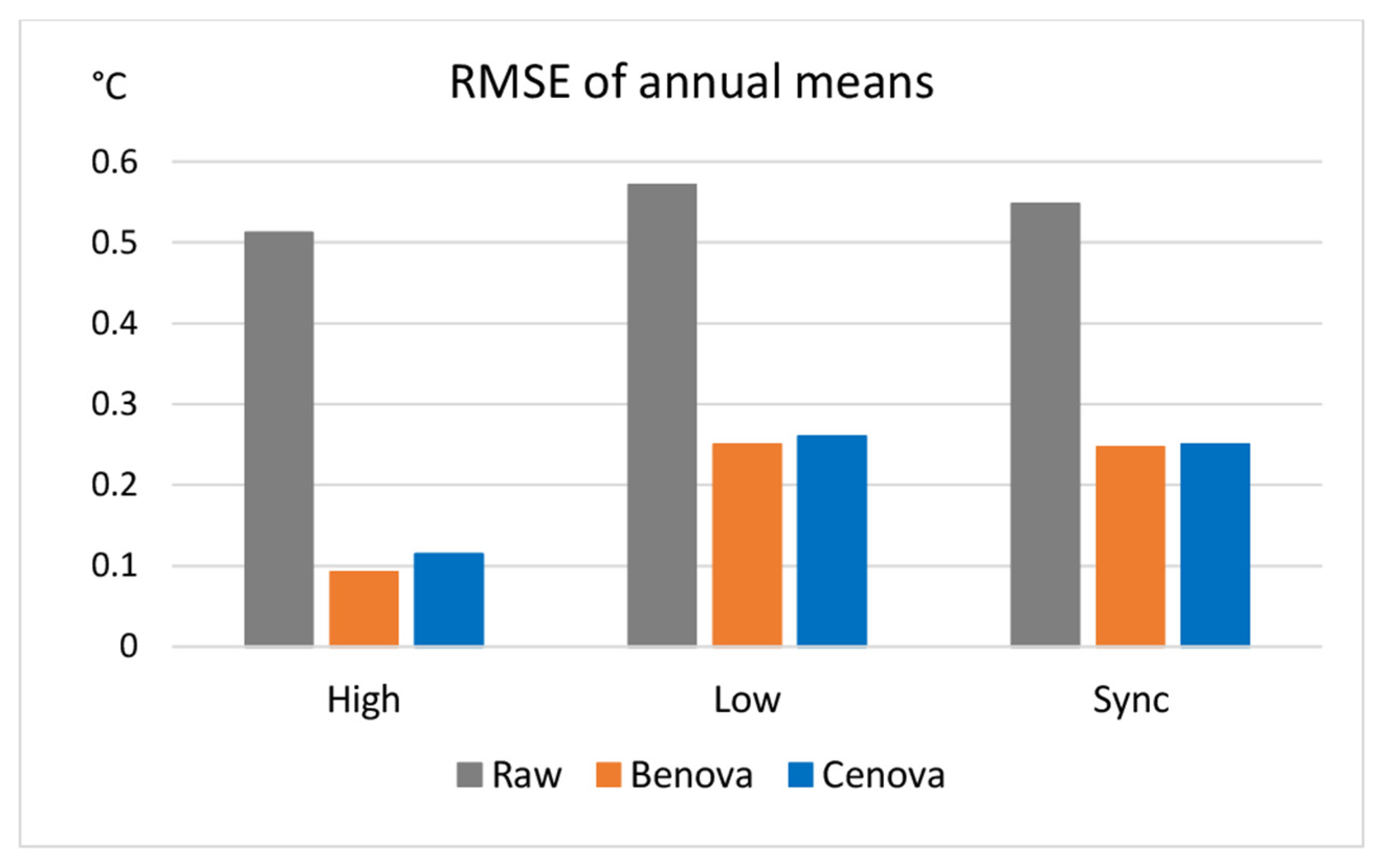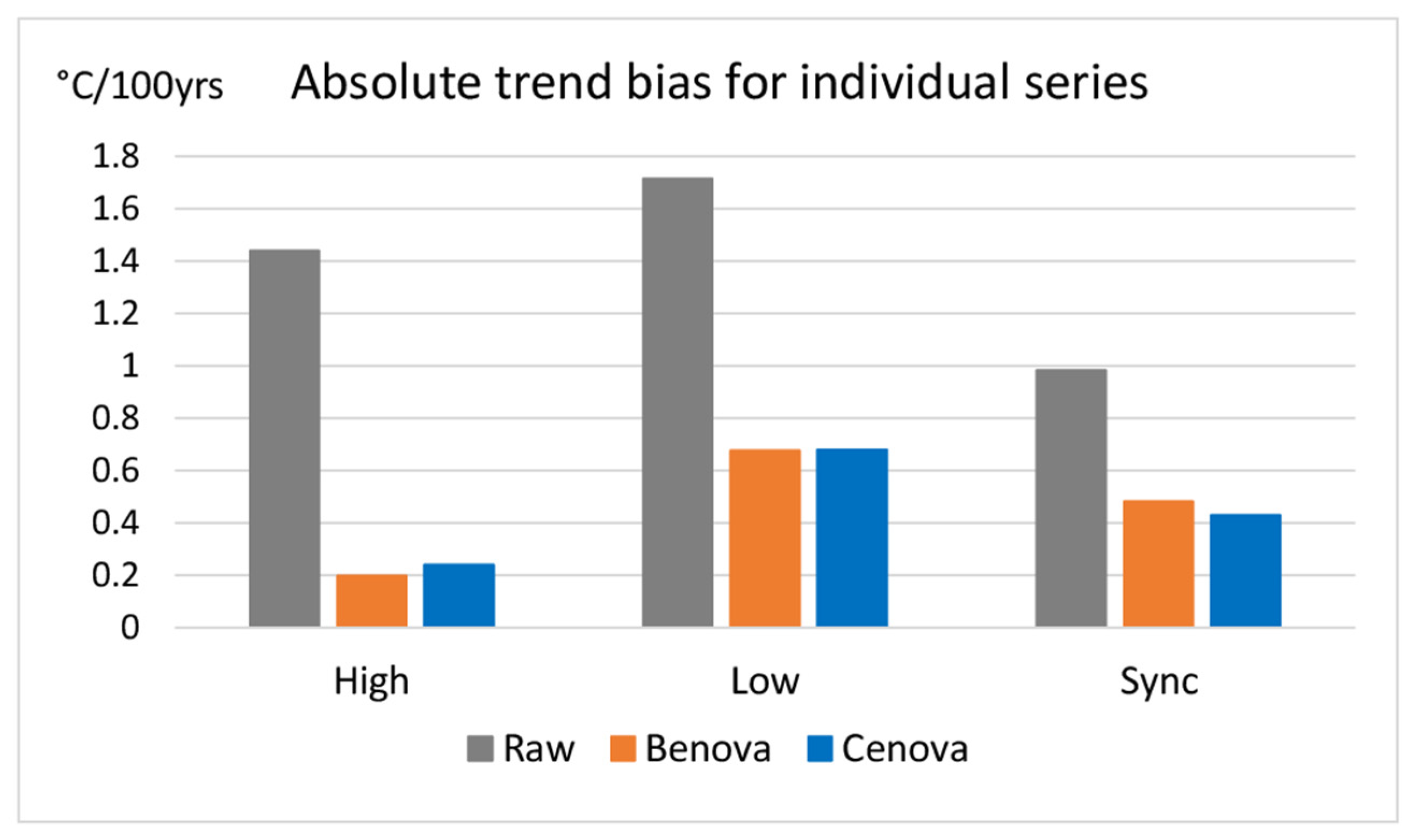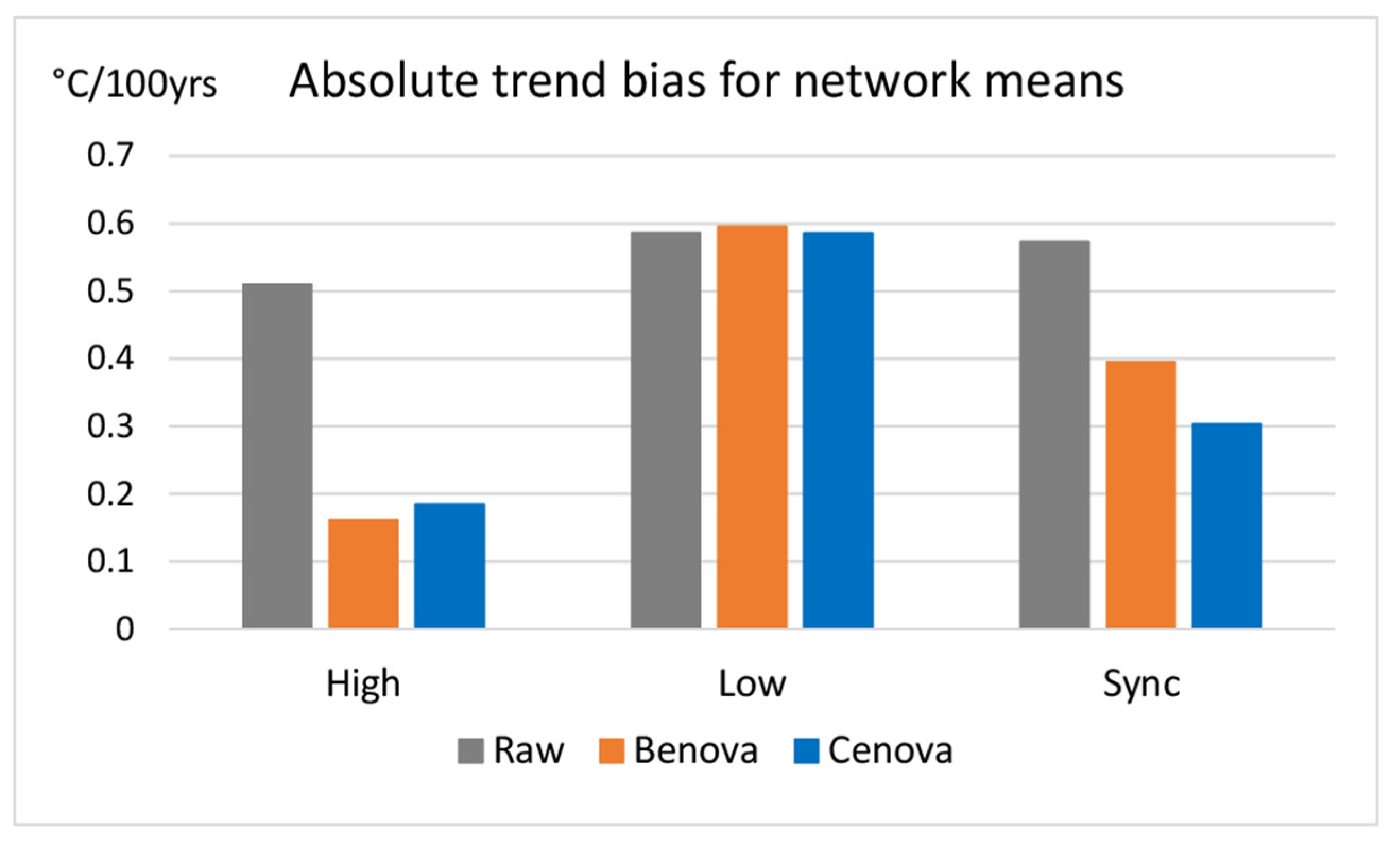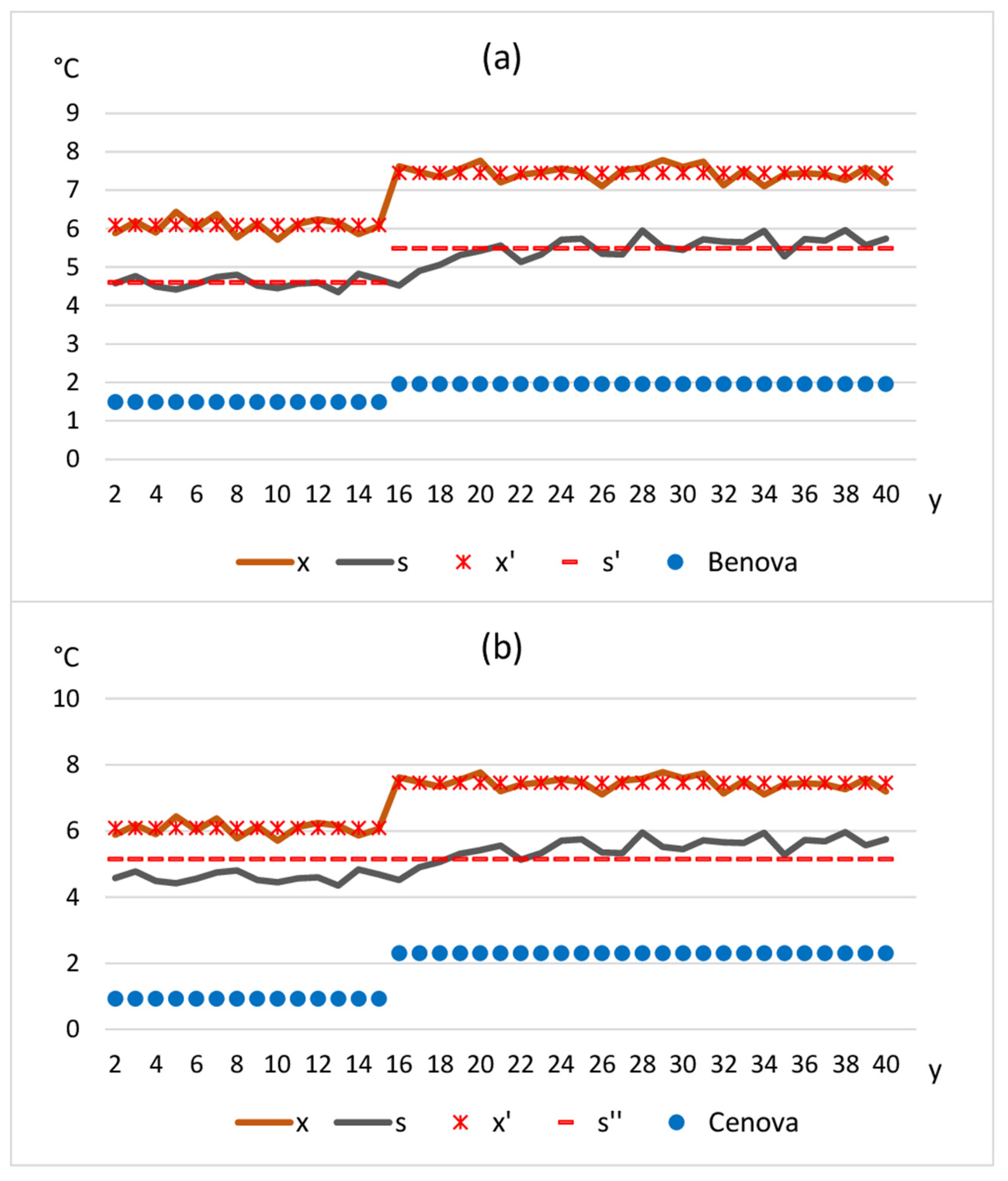Benova and Cenova Models in the Homogenization of Climatic Time Series
Abstract
1. Introduction
2. Methods
2.1. Use of Statistical Models in Climatology
2.2. Benova Model
2.3. Cenova Model and the Homogenization of PDF
2.4. Removal of Network Mean Trend Before Applying Cenova
2.5. ACMANTv5.3
3. Comparative Tests for Benova and Cenova
3.1. Test Data
- (i)
- The homogeneous data must be perfectly known; therefore, only synthetically developed data can be used;
- (ii)
- The closeness to the real climate data properties, the size of the dataset and the variety of homogenization problems should allow for obtaining reliable test results;
- (iii)
- Both the Benova and Cenova models can be applied.
3.2. Execution of Tests
3.3. Test Results
4. Discussion
4.1. Impacts of Undetected Breaks and Network Mean Inhomogeneity Bias
4.2. Reliability of Test Results
4.3. Options for the Joint Calculation of Correction Terms for the Data of Discontinuous Time Series
- (i)
- Infilling data gaps before the homogenization of percentile ranges.
- (ii)
- Homogenization in the annual resolution, after the modification of the input data of PDF homogenization, in the way described in Section 2.4.
- (iii)
- Shortening the HSP* sections as long as none of such sections overlap break timings, not even when the break is in another time series than the HSP*.
- (iv)
- Dates without observed values can be skipped before using Benova.
4.4. When to Use Benova and Cenova
5. Conclusions
- When the signal-to-noise ratio (SNR) is favorable, ACMANT removes the major part of the raw data errors. The results produced by using Benova are the most accurate, but the residual errors after homogenization are not much larger, even when Cenova is applied instead of Benova.
- When the SNR is low, or the time series are affected by synchronous or semi-synchronous inhomogeneities (clustered breaks), the efficiency of ACMANT is much lower than for high-SNR tasks, and the differences between the Benova results and Cenova results are generally very small.
- Low SNR and clustered break problems mostly affect the removal of network mean trend biases. When clustered breaks occur, Cenova tends to provide better results in trend bias removal, particularly in the removal of network mean trends.
- The use of Benova should be prioritized over Cenova when the conditions allow for choosing between them, despite the fact that occasionally Cenova could produce the best results.
- For the homogenization of probability distribution (PDF), Cenova can safely be applied, once the low-frequency variation of the estimated climate signal has been removed from each time series.
Funding
Data Availability Statement
Conflicts of Interest
Abbreviations
| ECV | Essential climate variable |
| HPDTS | Homogenization of probability distribution for time series |
| HSP | Homogeneous sub-period |
| HSP* | Section of time series whose daily data are substituted with the section average |
| Probability distribution | |
| QM | Quantile matching |
| RMSE | Root mean square error |
| SNR | Signal-to-noise ratio |
Appendix A
| Dataset | Raw | Benova | Cenova | Dataset | Raw | Benova | Cenova |
|---|---|---|---|---|---|---|---|
| Y1 | 0.530 | 0.062 | 0.085 | U1 | 0.274 | 0.124 | 0.151 |
| Y2 | 0.530 | 0.092 | 0.106 | U2 | 0.464 | 0.156 | 0.181 |
| Y3 | 0.530 | 0.192 | 0.198 | U3 | 1.238 | 0.528 | 0.529 |
| Y4 | 0.522 | 0.059 | 0.084 | U4 | 0.240 | 0.156 | 0.161 |
| Y5 | 0.527 | 0.210 | 0.217 | U5 | 0.407 | 0.129 | 0.154 |
| Y6 | 0.568 | 0.284 | 0.284 | U6 | 0.824 | 0.272 | 0.285 |
| Dataset | Raw | Benova | Cenova | Dataset | Raw | Benova | Cenova |
|---|---|---|---|---|---|---|---|
| Y1 | 1.467 | 0.134 | 0.178 | U1 | 0.844 | 0.311 | 0.374 |
| Y2 | 1.467 | 0.226 | 0.244 | U2 | 1.370 | 0.311 | 0.349 |
| Y3 | 1.467 | 0.481 | 0.452 | U3 | 3.419 | 1.284 | 1.245 |
| Y4 | 1.450 | 0.115 | 0.182 | U4 | 1.130 | 0.625 | 0.645 |
| Y5 | 0.888 | 0.342 | 0.291 | U5 | 0.840 | 0.213 | 0.250 |
| Y6 | 1.075 | 0.619 | 0.565 | U6 | 1.749 | 0.412 | 0.445 |
| Dataset | Raw | Benova | Cenova | Dataset | Raw | Benova | Cenova |
|---|---|---|---|---|---|---|---|
| Y1 | 0.453 | 0.114 | 0.118 | U1 | 0.244 | 0.274 | 0.331 |
| Y2 | 0.453 | 0.187 | 0.191 | U2 | 0.872 | 0.292 | 0.330 |
| Y3 | 0.453 | 0.366 | 0.351 | U3 | 1.105 | 1.223 | 1.135 |
| Y4 | 0.260 | 0.050 | 0.097 | U4 | 0.541 | 0.519 | 0.521 |
| Y5 | 0.389 | 0.246 | 0.151 | U5 | 0.457 | 0.194 | 0.251 |
| Y6 | 0.757 | 0.544 | 0.456 | U6 | 0.600 | 0.378 | 0.433 |
References
- Bojinski, S.; Verstraete, M.; Peterson, T.C.; Richter, C.; Simmons, A.; Zemp, M. The concept of essential climate variables in support of climate research, applications, and policy. Bull. Amer. Met. Soc. 2014, 95, 1431–1443. [Google Scholar] [CrossRef]
- McKinnon, K.; National Center for Atmospheric Research Staff (Eds.) The Climate Data Guide: GHCN-D: Global Historical Climatology Network Daily Temperatures. Available online: https://climatedataguide.ucar.edu/climate-data/ghcn-d-global-historical-climatology-network-daily-temperatures (accessed on 5 June 2025).
- Aguilar, E.; Auer, I.; Brunet, M.; Peterson, T.C.; Wieringa, J. Guidelines on Climate Metadata and Homogenization; WCDMP-53, WMO-TD 1186; World Meteorological Organization: Geneva, Switzerland, 2003. [Google Scholar]
- Auer, I.; Böhm, R.; Jurkovic, A.; Orlik, A.; Potzmann, R.; Schöner, W.; Ungersböck, M.; Brunetti, M.; Nanni, T.; Maugeri, M.; et al. A new instrumental precipitation dataset for the Greater Alpine Region for the period 1800–2002. Int. J. Climatol. 2005, 25, 139–166. [Google Scholar] [CrossRef]
- Prohom, M.; Barriendos, M.; Sanchez-Lorenzo, A. Reconstruction and homogenization of the longest instrumental precipi-tation series in the Iberian Peninsula (Barcelona, 1786–2014). Int. J. Climatol. 2016, 36, 3072–3087. [Google Scholar] [CrossRef]
- Camuffo, D.; della Valle, A.; Becherini, F. Instrumental and observational problems of the earliest temperature records in Italy: A methodology for data recovery and correction. Climate 2023, 11, 178. [Google Scholar] [CrossRef]
- Alexandersson, H.; Moberg, A. Homogenization of Swedish temperature data. Part I: Homogeneity test for linear trends. Int. J. Climatol. 1997, 17, 25–34. [Google Scholar] [CrossRef]
- Vincent, L.A. A technique for the identification of inhomogeneities in Canadian temperature series. J. Clim. 1998, 11, 1094–1104. [Google Scholar] [CrossRef]
- Menne, M.J.; Williams Jr, C.N. Homogenization of temperature series via pairwise comparisons. J. Clim. 2009, 22, 1700–1717. [Google Scholar] [CrossRef]
- Domonkos, P. Efficiency evaluation for detecting inhomogeneities by objective homogenisation methods. Theor. Appl. Climatol. 2011, 105, 455–467. [Google Scholar] [CrossRef]
- Williams, C.N.; Menne, M.J.; Thorne, P. Benchmarking the performance of pairwise homogenization of surface temperatures in the United States. J. Geophys. Res. 2012, 117, D05116. [Google Scholar] [CrossRef]
- Lindau, R.; Venema, V.K.C. The joint influence of break and noise variance on the break detection capability in time series homogenization. Adv. Stat. Clim. Meteorol. Oceanogr. 2018, 4, 1–18. [Google Scholar] [CrossRef]
- Venema, V.; Trewin, B.; Wang, X.L.; Szentimrey, T.; Lakatos, M.; Aguilar, E.; Auer, I.; Guijarro, J.; Menne, M.; Oria, C.; et al. Guidelines on Homogenization; WMO-No. 1245; World Meteorological Organization: Geneva, Switzerland, 2020. [Google Scholar]
- Domonkos, P.; Tóth, R.; Nyitrai, L. Climate Observations: Data Quality Control and Time Series Homogenization; Elsevier: Amsterdam, The Netherlands, 2022; 302p. [Google Scholar]
- de Valk, C.; Brandsma, T. Homogenization of daily temperatures using covariates and statistical learning—The case of parallel measurements. Int. J. Climatol. 2023, 43, 7170–7182. [Google Scholar] [CrossRef]
- Katata, G.; Connolly, R.; O’Neill, P. Evidence of urban blending in homogenized temperature records in Japan and in the United States: Implications for the reliability of global land surface air temperature data. J. Appl. Meteor. Climatol. 2023, 62, 1095–1114. [Google Scholar] [CrossRef]
- Lund, R.B.; Beaulieu, C.; Killick, R.; Lu, Q.; Shi, X. Good practices and common pitfalls in climate time series changepoint techniques: A review. J. Clim. 2023, 36, 8041–8057. [Google Scholar] [CrossRef]
- Chimani, B.; Bochníček, O.; Brunetti, M.; Ganekind, M.; Holec, J.; Izsák, B.; Lakatos, M.; Tadić, M.P.; Manara, V.; Maugeri, M.; et al. Revisiting HISTALP precipitation dataset. Int. J. Climatol. 2023, 43, 7381–7411. [Google Scholar] [CrossRef]
- Domonkos, P. Relative homogenization of climatic time series. Atmosphere 2024, 15, 957. [Google Scholar] [CrossRef]
- Lindau, R. Estimation of break and noise variance and the maximum distance of climate stations allowed in relative homogenisation of annual temperature anomalies. Int. J. Climatol. 2025, 45, e8724. [Google Scholar] [CrossRef]
- Brunet, M.; Asin, J.; Sigró, J.; Bañon, M.; García, F.; Aguilar, E.; Palenzuela, J.E.; Peterson, T.C.; Jones, P. The minimization of the screen bias from ancient Western Mediterranean air temperature records: An exploratory statistical analysis. Int. J. Climatol. 2011, 31, 1879–1895. [Google Scholar] [CrossRef]
- Vincent, L.A.; Wang, X.L.; Milewska, E.J.; Wan, H.; Yang, F.; Swail, V. A second generation of homogenized Canadian monthly surface air temperature for climate trend analysis. J. Geophys. Res. 2012, 117, D18110. [Google Scholar] [CrossRef]
- Hannak, L.; Friedrich, K.; Imbery, F.; Kaspar, F. Analyzing the impact of automatization using parallel daily mean temperature series including breakpoint detection and homogenization. Int. J. Climatol. 2020, 40, 6544–6559. [Google Scholar] [CrossRef]
- Ashcroft, L.; Trewin, B.; Benoy, M.; Ray, D.; Courtney, C. The world’s longest known parallel temperature dataset: A comparison between daily Glaisher and Stevenson screen temperature data at Adelaide, Australia, 1887–1947. Int. J. Climatol. 2022, 42, 2670–2687. [Google Scholar] [CrossRef]
- Wallis, E.J.; Osborn, T.J.; Taylor, M.; Jones, P.D.; Joshi, M.; Hawkins, E. Quantifying exposure biases in early instrumental land surface air temperature observations. Int. J. Climatol. 2024, 44, 1611–1635. [Google Scholar] [CrossRef]
- Venema, V.; Mestre, O.; Aguilar, E.; Auer, I.; Guijarro, J.A.; Domonkos, P.; Vertacnik, G.; Szentimrey, T.; Štěpánek, P.; Zahradníček, P.; et al. Benchmarking monthly homogenization algorithms. Clim. Past 2012, 8, 89–115. [Google Scholar] [CrossRef]
- Killick, R.E. Benchmarking the Performance of Homogenisation Algorithms on Daily Temperature Data. Ph.D. Thesis, University of Exeter, Exeter, UK, 2016. [Google Scholar]
- Guijarro, J.A. Recommended Homogenization Techniques Based on Benchmarking Results; WP-3 Report of INDECIS Project. 2019. Available online: http://www.indecis.eu/docs/Deliverables/Deliverable_3.2.b.pdf (accessed on 5 June 2025).
- Domonkos, P.; Guijarro, J.A.; Venema, V.; Brunet, M.; Sigró, J. Efficiency of time series homogenization: Method comparison with 12 monthly temperature test datasets. J. Clim. 2021, 34, 2877–2891. [Google Scholar] [CrossRef]
- Guijarro, J.A.; López, J.A.; Aguilar, E.; Domonkos, P.; Venema, V.K.C.; Sigró, J.; Brunet, M. Homogenization of monthly series of temperature and precipitation: Benchmarking results of the MULTITEST project. Int. J. Climatol. 2023, 43, 3994–4012. [Google Scholar] [CrossRef]
- Wilcoxon, F. Individual comparisons by ranking methods. Biom. Bull. 1945, 1, 80–83. [Google Scholar] [CrossRef]
- Maronna, R.; Yohai, V.J. A bivariate test for the detection of a systematic change in mean. J. Am. Stat. Assoc. 1978, 73, 640–645. [Google Scholar] [CrossRef]
- Craddock, J.M. Methods of comparing annual rainfall records for climatic purposes. Weather 1979, 34, 332–346. [Google Scholar] [CrossRef]
- Alexandersson, H. A homogeneity test applied to precipitationdata. J. Climatol. 1986, 6, 661–675. [Google Scholar] [CrossRef]
- Szentimrey, T. Multiple Analysis of Series for Homogenization (MASH). In Second Seminar for Homogenization of Surface Climatological Data; Szalai, S., Szentimrey, T., Szinell, C., Eds.; WMO WCDMP-41; World Meteorological Organization: Geneva, Switzerland, 1999; pp. 27–46. [Google Scholar]
- Caussinus, H.; Mestre, O. Detection and correction of artificial shifts in climate series. J. R. Stat. Soc. Ser. C Appl. Stat. 2004, 53, 405–425. [Google Scholar] [CrossRef]
- Menne, M.J.; Williams, C.N.; Vose, R.S. The U.S. Historical Climatology Network Monthly Temperature Data, Version 2. Bull. Am. Meteor. Soc. 2009, 90, 993–1008. [Google Scholar] [CrossRef]
- Štěpánek, P.; Zahradnicek, P.; Farda, A. Experiences with data quality control and homogenisation of daily records of various meteorological elements in the Czech Republic in the period 1961-2010. Időjárás 2013, 117, 123–141. [Google Scholar]
- Lindau, R.; Venema, V.K.C. The uncertainty of break positions detected by homogenization algorithms in climate records. Int. J. Climatol. 2016, 36, 576–589. [Google Scholar] [CrossRef]
- O’Neill, P.; Connolly, R.; Connolly, M.; Soon, W.; Chimani, B.; Crok, M.; de Vos, R.; Harde, H.; Kajaba, P.; Nojarov, P.; et al. Evaluation of the homogenization adjustments applied to European temperature records in the Global Historical Climatology Network Dataset. Atmosphere 2022, 13, 285. [Google Scholar] [CrossRef]
- Domonkos, P.; Joelsson, L.M.T. ANOVA (Benova) correction in relative homogenization: Why it is indispensable. Int. J. Climatol. 2024, 44, 4515–4528. [Google Scholar] [CrossRef]
- Domonkos, P. Homogenization of the probability distribution of climatic time series: A novel algorithm. Atmosphere 2025, 16, 616. [Google Scholar] [CrossRef]
- Domonkos, P. ACMANTv4: Scientific Content and Operation of the Software, 2020; 71p. Available online: https://github.com/dpeterfree/ACMANT/blob/ACMANTv4.4/ACMANTv4_description.pdf (accessed on 5 June 2025).
- Domonkos, P. Combination of using pairwise comparisons and composite reference series: A new approach in the homogenization of climatic time series with ACMANT. Atmosphere 2021, 12, 1134. [Google Scholar] [CrossRef]
- Mamara, A.; Argiriou, A.A.; Anadranistakis, M. Detection and correction of inhomogeneities in Greek climate temperature series. Int. J. Climatol. 2014, 34, 3024–3043. [Google Scholar] [CrossRef]
- Lindau, R.; Venema, V.K.C. On the reduction of trend errors by the ANOVA joint correction scheme used in homogenization of climate station records. Int. J. Climatol. 2018, 38, 5255–5271. [Google Scholar] [CrossRef]
- Szentimrey, T. Methodological questions of series comparison. In Proceedings of the Sixth Seminar for Homogenization and Quality Control in Climatological Databases, Budapest, Hungary, 26–30 May 2008; Lakatos, M., Szentimrey, T., Bihari, Z., Szalai, S., Eds.; WMO WCDMP-76. World Meteorological Organization: Geneva, Switzerland, 2010; pp. 1–7. [Google Scholar]
- Della-Marta, P.M.; Wanner, H. A method of homogenizing the extremes and mean of daily temperature measurements. J. Clim. 2006, 19, 4179–4197. [Google Scholar] [CrossRef]
- Mestre, O.; Gruber, C.; Prieur, C.; Caussinus, H.; Jourdain, S. SPLIDHOM: A method for homogenization of daily temperature observations. J. Appl. Meteorol. Climatol. 2011, 50, 2343–2358. [Google Scholar] [CrossRef]
- Squintu, A.A.; van der Schrier, G.; Brugnara, Y.; Klein Tank, A. Homogenization of daily temperature series in the European Climate Assessment & Dataset. Int. J. Climatol. 2019, 39, 1243–1261. [Google Scholar] [CrossRef]
- Squintu, A.A.; van der Schrier, G.; Štěpánek, P.; Zahradníček, P.; Klein Tank, A. Comparison of homogenization methods for daily temperature series against an observation-based benchmark dataset. Theor. Appl. Climatol. 2020, 140, 285–301. [Google Scholar] [CrossRef]
- Trewin, B.; Braganza, K.; Fawcett, R.; Grainger, S.; Jovanovic, B.; Jones, D.; Martin, D.; Smalley, R.; Webb, V. An updated long-term homogenized daily temperature data set for Australia. Geosci. Data J. 2020, 7, 149–169. [Google Scholar] [CrossRef]
- Brugnara, Y.; McCarthy, M.P.; Willett, K.M.; Rayner, N.A. Homogenization of daily temperature and humidity series in the UK. Int. J. Climatol. 2023, 43, 1693–1709. [Google Scholar] [CrossRef]
- Resch, G.; Koch, R.; Marty, C.; Chimani, B.; Begert, M.; Buchmann, M.; Aschauer, J.; Schöner, W. A quantile-based approach to improve homogenization of snow depth time series. Int. J. Climatol. 2023, 43, 157–173. [Google Scholar] [CrossRef]
- Chen, J.; Hu, T.; Wang, J.; Yan, Z.; Li, Z. A method for homogenization of complex daily mean temperature data: Application at Beijing Observatory (1915–2021) and trend analysis. Int. J. Climatol. 2024, 44, 1955–1973. [Google Scholar] [CrossRef]
- Kunert, L.; Friedrich, K.; Imbery, F.; Kaspar, F. Homogenization of German daily and monthly mean temperature time series. Int. J. Climatol. 2024, 44, 775–791. [Google Scholar] [CrossRef]
- Domonkos, P. Time series homogenization with ACMANT: Comparative testing of two recent versions in large-size synthetic temperature datasets. Climate 2023, 11, 224. [Google Scholar] [CrossRef]
- Caussinus, H.; Lyazrhi, F. Choosing a linear model with a random number of change-points and outliers. Ann. Inst. Stat. Math. 1997, 49, 761–775. [Google Scholar] [CrossRef]
- Prohom, M.; Domonkos, P.; Cunillera, J.; Barrera-Escoda, A.; Busto, M.; Herrero-Anaya, M.; Aparicio, A.; Reynés, J. CADTEP: A new daily quality-controlled and homogenized climate database for Catalonia (1950–2021). Int. J. Climatol. 2023, 43, 4771–4789. [Google Scholar] [CrossRef]
- Peterson, T.C.; Easterling, D.R. Creation of homogeneous composite climatological reference series. Int. J. Climatol. 1994, 14, 671–679. [Google Scholar] [CrossRef]
- Domonkos, P. Automatic homogenization of time series: How to use metadata? Atmosphere 2022, 13, 1379. [Google Scholar] [CrossRef]
- Domonkos, P.; Guijarro, J.A.; Venema, V.; Brunet, M.; Sigró, J. Benchmark Dataset of MULTITEST—TEMP12. 2020. Available online: https://zenodo.org/record/4421765#.X_YDpxaCHIU (accessed on 5 June 2025).
- Guijarro, J.A. Homogenization of Climatic Series with Climatol. 2018. Available online: https://www.climatol.eu (accessed on 5 June 2025).
- Azorin-Molina, C.; Guijarro, J.A.; McVicar, T.R.; Trewin, B.C.; Frost, A.J.; Chen, D. An approach to homogenize daily peak wind gusts: An application to the Australian series. Int. J. Climatol. 2019, 39, 2260–2277. [Google Scholar] [CrossRef]
- Izsák, B.; Szentimrey, T. To what extent does the detection of climate change in Hungary depend on the choice of statistical methods? Int J Geomath. 2020, 11, 17. [Google Scholar] [CrossRef]
- Wang, X.L.; Wen, Q.H.; Wu, Y. Penalized maximal t test for detecting undocumented mean change in climate data series. J. Appl. Meteor. Climatol. 2007, 46, 916–931. [Google Scholar] [CrossRef]
- Wang, X.L.; Chen, H.; Wu, Y.; Feng, Y.; Pu, Q. New techniques for the detection and adjustment of shifts in daily precipitation data series. J. Appl. Meteor. Climatol. 2010, 49, 2416–2436. [Google Scholar] [CrossRef]
- Gillespie, I.M.; Haimberger, L.; Compo, G.P.; Thorne, P.W. Assessing potential of sparse-input reanalyses for centennial-scale land surface air temperature homogenization. Int. J. Climatol. 2021, 41, E3000–E3020. [Google Scholar] [CrossRef]
- Taylor, M.; Osborn, T.J.; Cowtan, K.; Morice, C.P.; Jones, P.D.; Wallis, E.J.; Lister, D.H. GloSAT LATsdb: A global compilation of land air temperature station records with updated climatological normals from local expectation kriging. Geosci. Data J. 2025, 12, e70024. [Google Scholar] [CrossRef]
- della Valle, A.; Becherini, F.; Camuffo, D. Recovery and reconstructions of 18th century precipitation records in Italy: Problems and analyses. Climate 2025, 13, 131. [Google Scholar] [CrossRef]
- Joelsson, L.M.T.; Sturm, C.; Södling, J.; Engström, E.; Kjellström, E. Automation and evaluation of the interactive homogenization tool HOMER. Int. J. Climatol. 2022, 42, 2861–2880. [Google Scholar] [CrossRef]
- Joelsson, L.M.T.; Engström, E.; Kjellström, E. Homogenization of Swedish mean monthly temperature series 1860–2021. Int. J. Climatol. 2023, 43, 1079–1093. [Google Scholar] [CrossRef]
- Mestre, O.; Domonkos, P.; Picard, F.; Auer, I.; Robin, S.; Lebarbier, E.; Böhm, R.; Aguilar, E.; Guijarro, J.; Vertacnik, G.; et al. HOMER: Homogenization software in R—Methods and applications. Időjárás 2013, 117, 47–67. [Google Scholar]
- Rustemeier, E.; Kapala, A.; Meyer-Christoffer, A.; Finger, P.; Schneider, U.; Venema, V.; Ziese, M.; Simmer, C.; Becker, A. HOMPRA Europe—A gridded precipitation data set from European homogenized time series. In Proceedings of the Ninth Semi-nar for Homogenization and Quality Control in Climatological Databases, Budapest, Hungary, 3–7 April 2017; Szentimrey, T., Lakatos, M., Hoffmann, L., Eds.; WMO WCDMP-85. WMO: Geneva, Switzerland, 2017; pp. 88–101. [Google Scholar]
- Shang, Y.; Xia, Z.; Xiao, Z.; Shum, W.Y. An analysis of the time-lag effect of global geopolitical risk on business cycle based on visibility graph technique. Technol. Forecast. Soc. 2024, 209, 123823. [Google Scholar] [CrossRef]
- Shrestha, M.B.; Bhatta, G.R. Selecting appropriate methodological framework for time series data analysis. J. Financ. Data Sci. 2018, 4, 71–89. [Google Scholar] [CrossRef]
- Kalsie, A.; Arora, A. Structural break, US financial crisis and macroeconomic time series: Evidence from BRICS economies. Transnatl. Corp. Rev. 2019, 11, 250–264. [Google Scholar] [CrossRef]





| Benova | Cenova | |
|---|---|---|
| Number of time series | 3≤ | 3≤ |
| Spatial correlations 1,2 | 0.4≤ | 0.4≤ |
| Form of inhomogeneities 3 | Breaks | Breaks |
| Low-frequency climate variation | Any | Reduced |
| Continuity of time series | Required | Not required |
Disclaimer/Publisher’s Note: The statements, opinions and data contained in all publications are solely those of the individual author(s) and contributor(s) and not of MDPI and/or the editor(s). MDPI and/or the editor(s) disclaim responsibility for any injury to people or property resulting from any ideas, methods, instructions or products referred to in the content. |
© 2025 by the author. Licensee MDPI, Basel, Switzerland. This article is an open access article distributed under the terms and conditions of the Creative Commons Attribution (CC BY) license (https://creativecommons.org/licenses/by/4.0/).
Share and Cite
Domonkos, P. Benova and Cenova Models in the Homogenization of Climatic Time Series. Climate 2025, 13, 199. https://doi.org/10.3390/cli13100199
Domonkos P. Benova and Cenova Models in the Homogenization of Climatic Time Series. Climate. 2025; 13(10):199. https://doi.org/10.3390/cli13100199
Chicago/Turabian StyleDomonkos, Peter. 2025. "Benova and Cenova Models in the Homogenization of Climatic Time Series" Climate 13, no. 10: 199. https://doi.org/10.3390/cli13100199
APA StyleDomonkos, P. (2025). Benova and Cenova Models in the Homogenization of Climatic Time Series. Climate, 13(10), 199. https://doi.org/10.3390/cli13100199






